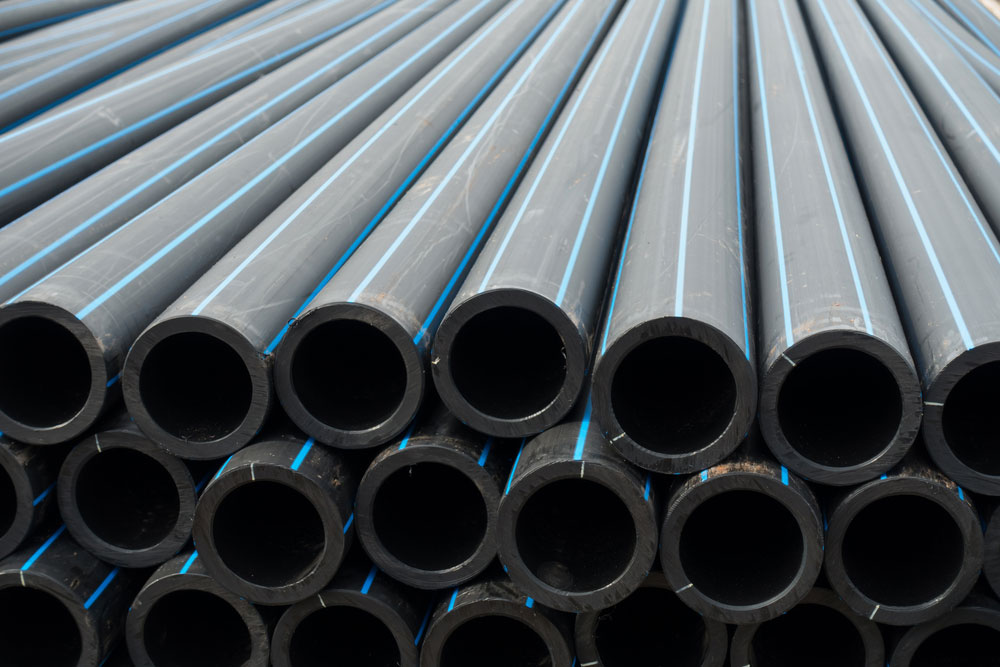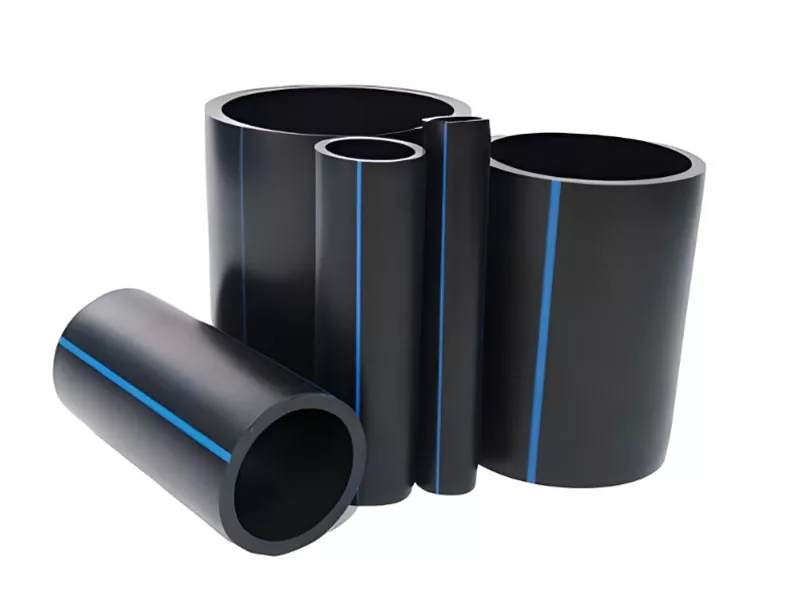Discover the Manufacturing Refine Behind High-Quality HDPE Pipe and Its Applications
The manufacturing process of high-grade HDPE pipelines is complex and methodical. It starts with the selection of resources that enhance performance. Following this, ethylene undergoes polymerization to develop resin, which is then shaped via extrusion. Quality control is critical, making certain that the final product satisfies strict standards. Nonetheless, the trip of HDPE pipelines doesn't finish with manufacturing. Their applications across different markets disclose a wider relevance worth analyzing.
Understanding HDPE: Characteristics and Advantages

High-density polyethylene (HDPE) is a functional polycarbonate known for its sturdiness and resistance to different environmental variables. This product displays excellent tensile stamina, making it ideal for requiring applications. Its low-density structure adds to a light-weight item, promoting convenience of dealing with and installment. HDPE also showcases impressive resistance to chemicals, which decreases degradation when subjected to severe compounds.
The material's reduced dampness absorption additionally improves its long life, making it ideal for usage in pipes and tank. In addition, HDPE is resistant to ultraviolet (UV) radiation, ensuring that items keep their stability also when subjected to sunlight. Its flexibility permits for the creation of intricate shapes without jeopardizing strength. The environment-friendly nature of HDPE, frequently obtained from recycled materials, contributes to its appeal, advertising sustainable practices in production. Overall, these homes and benefits make HDPE a recommended option for various commercial and consumer applications.
Basic Material Selection for HDPE Manufacturing
The choice of raw materials for HDPE production is important to confirm the last item satisfies the wanted specs and top quality requirements. High-density polyethylene (HDPE) is largely produced from polymerized ethylene, originated from nonrenewable fuel sources such as gas or crude oil. The high quality of these feedstocks significantly affects the mechanical and thermal properties of the last HDPE.
Additives likewise play a significant function in boosting HDPE's performance, including antioxidants, UV stabilizers, and colorants, which boost sturdiness and resistance to ecological factors. The choice process should take into consideration not only the chemical structure of the raw materials however also their handling features to guarantee reliable manufacturing.
The sourcing of raw products must prioritize sustainability and conformity with environmental guidelines, as responsible methods are vital in today's market. Inevitably, careful basic material selection lays the structure for creating high-grade HDPE pipes ideal for varied applications.
The Extrusion Refine: Forming HDPE Pipeline
The extrusion procedure plays a vital role fit HDPE pipes, starting with meticulous material prep work methods that assure perfect circulation and consistency. Equally crucial is the style of the die, which directly affects the final measurements and surface area quality of the pipeline. With each other, these factors contribute significantly to the effectiveness and top quality of HDPE pipeline manufacturing.
Product Preparation Strategies
Reliable manufacturing of HDPE pipes begins with careful material preparation methods, specifically the extrusion procedure. During this stage, high-density polyethylene material is initial dried to eliminate moisture, guaranteeing excellent flow attributes. The material is then fed into the extruder, where it goes through home heating and melting, transforming right into a viscous state. This heating process is carefully managed to keep the material's stability and efficiency. The molten HDPE is forced through a die, shaping it into a constant pipeline form. Correct temperature management throughout extrusion is important, as it straight influences the material's residential properties and the last item quality. As soon as shaped, the HDPE pipeline is cooled down and reduced to defined sizes, all set for subsequent processing and applications.
Die Style Value
Accuracy in die style plays a vital role in the extrusion procedure of HDPE pipes. The die works as the final shaping device, straight affecting the pipe's measurements, wall density, and surface finish. A well-designed die assurances uniform material flow, decreasing defects such as irregularities and vulnerable points. The geometry of the die need to be optimized to suit the details properties of HDPE, including its viscosity and thermal habits during extrusion. Furthermore, the cooling price of the product as it passes through the die can considerably influence the pipe's structural integrity. Investing in advanced die innovation is important for producers intending to produce top notch HDPE pipelines that meet sector requirements and consumer assumptions.
Quality Assurance Measures in HDPE Production
Although numerous aspects influence the high quality of HDPE pipe manufacturing, effective high quality control steps are important to ensure uniformity and reliability in the last product. Trick quality control practices include extensive product evaluation, verifying that the raw polyethylene meets well established criteria for purity and thickness. Throughout the extrusion process, parameters such as temperature, stress, and cooling time are closely monitored to maintain dimensional accuracy and structural honesty
In addition, post-production screening is vital; producers often perform hydrostatic examinations to analyze the pipe's toughness and resistance to stress. Aesthetic examinations for surface area flaws further improve quality control. Qualification from pertinent standards organizations, like ASTM or ISO, offers an added layer of reliability. By executing these comprehensive quality control procedures, suppliers can reduce flaws, boost efficiency, and guarantee that the HDPE pipelines fulfill the certain requirements of numerous applications, ultimately leading to client fulfillment and depend on in the item.
Applications of HDPE Pipe Throughout Industries
HDPE pipes are used throughout various fields because of their sturdiness and versatility. In water circulation systems, they guarantee efficient distribution, while in wastewater administration, they provide reputable remedies for waste transport. In addition, farming watering networks gain from HDPE's resistance to deterioration and flexibility, making it a perfect option for modern farming practices.

Water Distribution Systems
A significant variety of sectors rely on high-density polyethylene (HDPE) pipelines for effective water circulation systems. Recognized for their durability and resistance to rust, HDPE pipes are extensively utilized in local water networks, agricultural watering, and industrial applications. Their lightweight nature assists in simple handling and installation, reducing labor prices and time. In addition, HDPE pipelines can accommodate different stress degrees, making them ideal for both reduced and high-pressure systems. American Plastics HDPE Pipe for Oilfield. The flexibility of the material allows for seamless combination right into existing framework, minimizing the requirement for extensive excavation. Furthermore, HDPE's resistance to chemical leaching warranties that the water provided remains risk-free and tidy, making it an optimal option for maintaining the high quality of potable water throughout numerous fields
Wastewater Monitoring Solutions
Reliable water circulation systems additionally lead the way for ingenious wastewater monitoring solutions, where high-density polyethylene (HDPE) pipes play a significant function. Popular for their longevity and resistance to rust, HDPE pipelines are perfect for moving wastewater in numerous setups. Their versatility permits for very easy installment in complex atmospheres, lessening the requirement for considerable excavation. In addition, HDPE's smooth interior surface minimizes rubbing, enhancing flow rates and performance. These pipelines are likewise resistant to chemical leaching, making sure that contaminants do not compromise the surrounding environment. Industries, towns, and therapy centers increasingly depend on HDPE pipelines for their integrity and long life, making them a recommended option for contemporary wastewater administration systems. This flexibility emphasizes the vital value of HDPE pipes across many applications.
Agricultural Watering Networks
Agricultural irrigation networks benefit significantly from the use of high-density polyethylene (HDPE) pipes, which offer reliable and reliable water delivery to crops. HDPE pipelines are light-weight, making them simple to carry and mount, while their adaptability permits different configurations in varied terrains. These pipelines show exceptional resistance to rust, chemicals, and UV radiation, ensuring longevity in harsh farming settings. Furthermore, their smooth interior surface minimizes rubbing loss, optimizing water circulation and minimizing energy expenses connected with pumping. The long life of HDPE pipelines, typically surpassing half a century, adds to lower upkeep and replacement expenses. Subsequently, farmers increasingly depend on HDPE pipelines to enhance irrigation performance and promote lasting agricultural techniques, eventually resulting in boosted crop returns and resource preservation.
Future Trends in HDPE Pipe Technology
As the demand for sustainable and efficient infrastructure expands, advancements in HDPE pipe technology are poised to transform numerous markets. Arising trends include the combination of clever modern technologies, such as sensors and IoT abilities, which facilitate real-time monitoring of pipeline problems, decreasing upkeep costs and preventing leaks. Furthermore, the growth of innovative production techniques, such as 3D printing, is allowing the manufacturing of complex, customized pipe styles that satisfy specific task demands.
The emphasis on recycling and round economic climate techniques is driving the technology of HDPE pipelines made from recycled materials, enhancing sustainability. Boosted jointing approaches, such as electro-fusion and mechanical installations, are likewise enhancing setup efficiency and reliability. Finally, the growing focus on ecological laws is pushing manufacturers to take on greener manufacturing procedures, making sure that HDPE pipes not only satisfy industry criteria however also cultivate a more lasting future for facilities development.
Regularly Asked Questions
How Does HDPE Compare to Various Other Plastic Materials?
HDPE outmatches several various other plastic materials concerning toughness, chemical resistance, and versatility. Its reduced density and high tensile stamina make it perfect for various applications, typically surpassing alternatives in both efficiency and long life.
What Are the Environmental Impacts of HDPE Production?
The environmental impacts of HDPE manufacturing include greenhouse gas exhausts, energy consumption, and potential pollution from producing processes. Additionally, incorrect disposal can result in dirt and water contamination, elevating problems regarding lasting environmental results.
Can HDPE Piping Be Recycled?
Yes, HDPE pipelines can be recycled. Numerous centers approve utilized HDPE for processing, transforming it into new products. This recycling contributes to sustainability efforts, reducing plastic waste while conserving sources and power in the production cycle.
What Is the Life Expectancy of HDPE Pipes?

How Do Temperature Variations Impact HDPE Pipe Efficiency?
Temperature variations substantially affect HDPE pipeline efficiency, affecting versatility and toughness. High temperatures can result in softening, while low temperatures might create brittleness, inevitably influencing the pipeline's sturdiness and suitability for numerous applications in diverse settings.